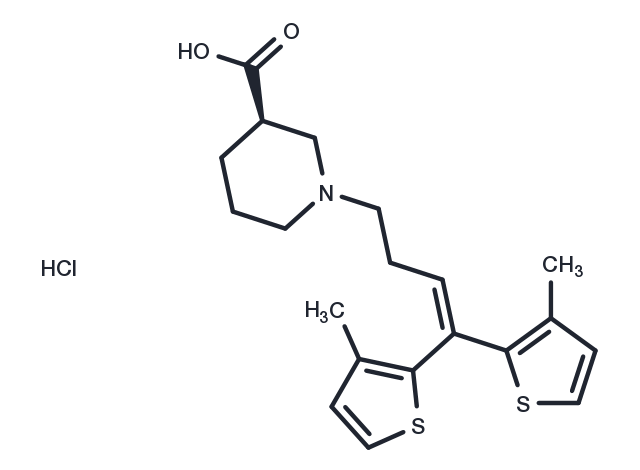Powder: -20°C for 3 years | In solvent: -80°C for 1 year


Tiagabine hydrochloride (NO050328 hydrochloride) is the hydrochloride salt form of tiagabine, a nipecotic acid derivative with anticonvulsant property. A selective gamma-aminobutyric acid (GABA) reuptake inhibitor.

| Pack Size | Availability | Price/USD | Quantity |
|---|---|---|---|
| 10 mg | In stock | $ 50.00 | |
| 25 mg | In stock | $ 63.00 | |
| 50 mg | In stock | $ 113.00 | |
| 100 mg | In stock | $ 203.00 | |
| 200 mg | In stock | $ 331.00 | |
| 1 mL * 10 mM (in DMSO) | In stock | $ 47.00 |



| Description | Tiagabine hydrochloride (NO050328 hydrochloride) is the hydrochloride salt form of tiagabine, a nipecotic acid derivative with anticonvulsant property. A selective gamma-aminobutyric acid (GABA) reuptake inhibitor. |
| In vitro | Tiagabine is a potent inhibitor of GABA uptake into neurons and glial cells. It is involved in modulating GABA levels, especially in areas such as the hippocampus and thalamus[2]. Tiagabine not only affected the decay kinetics of the IPSCs, it also reduced the frequency of occurrence of both spontaneous and miniature IPSCs[4]. |
| In vivo | Tiagabine offers a significant neuroprotection in global ischemia in gerbils when given 30 min before ischemia but not when given 3 h after ischemia[3]. |
| Synonyms | NO328 hydrochloride, NO050328 hydrochloride, TGB hydrochloride, Gabitril, Gabitril hydrochloride |
| Molecular Weight | 412.01 |
| Formula | C20H25NO2S2·HCl |
| CAS No. | 145821-59-6 |
Powder: -20°C for 3 years | In solvent: -80°C for 1 year
DMSO: 41.2 mg/mL (100 mM)
H2O: 20.6 mg/mL (50 mM)
You can also refer to dose conversion for different animals. More
bottom
Please see Inhibitor Handling Instructions for more frequently ask questions. Topics include: how to prepare stock solutions, how to store products, and cautions on cell-based assays & animal experiments, etc.
Tiagabine hydrochloride 145821-59-6 Membrane transporter/Ion channel Neuroscience GABA Receptor NO050328 TGB NO-050328 Hydrochloride NO328 hydrochloride NO-050328 γ-Aminobutyric acid Receptor NO 050328 NO050328 Hydrochloride TGB Hydrochloride NO 328 Hydrochloride inhibit Tiagabine Hydrochloride NO-328 Hydrochloride NO328 Hydrochloride NO-328 Gabitril Hydrochloride NO 050328 Hydrochloride NO328 NO050328 hydrochloride TGB hydrochloride Gamma-aminobutyric acid Receptor Gabitril Tiagabine NO 328 Gabitril hydrochloride Inhibitor inhibitor
